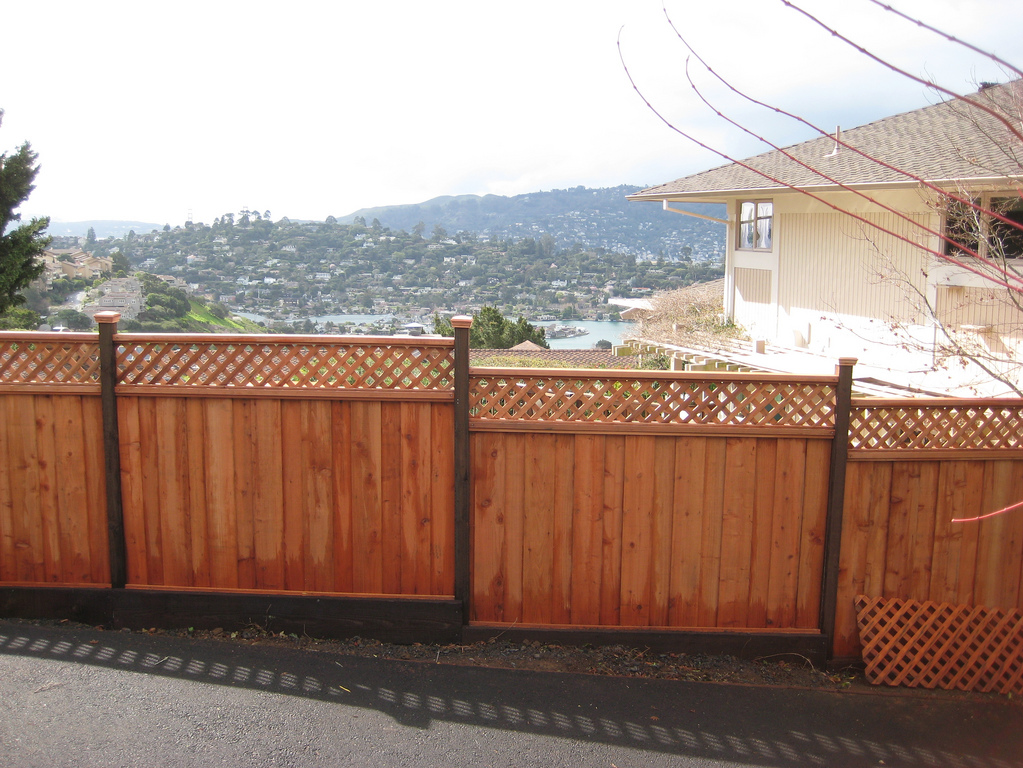Diamond Certified Experts: Wood Fence Replacement & Maintenance

Whether you’re installing, replacing or merely maintaining a wood fence, it’s good to know the basics about fencing. Photo: AMM Fencing ©2022
A wood fence serves many functions: it creates privacy, increases security, delineates property lines and adds aesthetic beauty to a property. However, even the best wood fences don’t last forever, which is why homeowners should learn about the basics of fence replacement and maintenance. We asked three Diamond Certified Expert Contributors in the fencing industry to share their insights on this topic.
Knowing When to Replace Your Fence
While it’s often possible to repair a failing fence, in some cases it makes more sense to just replace it. Leland Char of AMM Fencing says one potential indicator of the latter scenario is a proliferation of decay. “Cracks and holes in a fence’s wood are typically signs of decay or rot,” he explains. “If one or two boards on your existing fence begin to decompose, you can generally fix the problem with wood, putty and steam. But if the problem extends beyond just a couple of boards, a repair probably won’t make fiscal sense. Furthermore, if you notice rotting or decay on the posts (which bear the weight of the entire fence), a domino effect is more than likely, and soon the whole length of the fence will begin to sag and sway.”
Mr. Char says another indicator that your fence needs to be replaced is if it’s leaning. “There are potential safety hazards that come with a leaning fence, so replacement is always recommended in this situation. Loose fence posts can be dangerous. During periods of heavy wind, they can become fully dislodged and carry large pieces of fence out of the ground. If this happens, there’s a risk of damage not only to your fence but to neighboring properties.”
Choosing Wood Fence Materials

Few consumers realize that redwood lumber comes in a wide variety of grades. Photo: Meza’s Fence ©2022
Buying cheap fence materials may save you money in the short term, but it could end up costing you more if your fence fails prematurely. That’s why it’s wise to choose lumber that’s designed to last. When it comes to wood fencing, redwood is far and away the most popular lumber choice, and for good reason—not only is it beautiful to look at, it naturally repels harmful insects and resists rot. However, few consumers realize that redwood lumber comes in a wide variety of grades. For this reason, it’s important to know exactly what you’re getting when choosing a redwood product for your new fence.
Julian Meza of Meza’s Fence breaks down the hierarchy of redwood grades into their most basic form. “Grades designated as ‘heart,’ such as Construction Heart, are sourced from heartwood, which is the inner part of the tree,” he explains. “Grades designated as ‘common,’ such as Construction Common, are sourced from sapwood, which is the living outer layer of the tree. In general, the higher redwood grades contain fewer and smaller knots, and they also tend to be more consistent in color.”
Due to the variety of redwood grades available, Mr. Meza recommends discussing them in detail with your fence contractor. He also advises verifying that your contractor’s proposal specifies the wood products to be used on your fencing project.
Fence Installation Tips
Choosing lumber is the first of many steps involved in installing a new wood fence. Mr. Meza offers a couple of additional recommendations for ensuring a quality final product.
- Insist on a better fastener. When building a fence, some contractors use nails while others use staples. However, since staples are smooth and thin, they’re more likely to come loose, especially as the wood contracts and expands in season. In contrast, galvanized nails provide a better grip and maintain a stronger bond between the wood materials.
- Make sure post concrete is above soil level. When pouring concrete for the fence posts, make sure it comes up above soil level. This will keep dirt off of the posts and protect them from erosion. Ideally, post concrete should be formed in the shape of a hill to ensure water runs off the concrete instead of pooling.
Maintaining Your Wood Fence

Most wood fences require some level of ongoing maintenance. Photo: Meza’s Fence 2022
The amount of maintenance a wood fence requires depends on a couple of factors, including the type of wood it’s made of and the homeowner’s aesthetic preferences. While woods like cedar need to be recurrently stained or painted to protect against moisture, Bob Easley of California Fencing says this isn’t the case with redwood. “Homeowners often assume they need to stain their redwood fences, but this is purely an aesthetic choice—it doesn’t actually help preserve the wood. The natural tannin contained in redwood enables it to resist the effects of weather, moisture and insects without the aid of sealants. Unstained redwood will eventually fade to an attractive gray, but its structural integrity will remain long after this occurs.” For those who choose to stain their redwood fences for aesthetic reasons, Mr. Easley recommends restaining every five years to maintain the desired coloration.
Mr. Easley has one final piece of advice for maintaining your wood fence. “If you have lawn sprinklers, make sure your fence isn’t in their line of fire,” he cautions. “Continuous exposure to sprinkler spray can cause fence boards to rot and fail prematurely, so adjust your sprinklers’ trajectory if needed.”
Use Diamond Certified Resource to find top rated companies.
Local, Top Rated Diamond Certified Companies Related to Your Topic
Contra Costa County Fence Contractors
Sonoma County Fence Contractors
Marin County Fence Contractors
Santa Clara County Fence Contractors
San Mateo County Fence Contractors
Related Articles
The Homeowner's Guide to Fences & Gates
Get Expert Advice From Owners of Top Rated Local Companies
Become a Diamond Certified Preferred Member (Always Free)